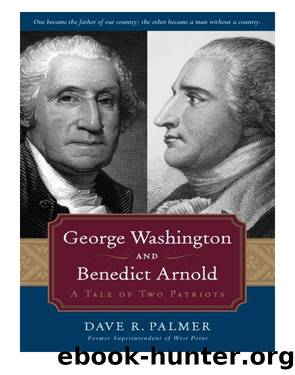George Washington and Benedict Arnold by Dave Richard Palmer

Author:Dave Richard Palmer
Language: eng
Format: epub
Publisher: Regnery History
Published: 2010-09-09T00:00:00+00:00
Two thousand British raiders, crack troops led by New Yorkâs ousted royal governor, William Tryon, reached Danbury late in the afternoon of April 26. Scattering the small contingent of guards, they started straightaway burning homes and barns and destroying stocks of supplies, finishing as darkness fell. His mission accomplished, Tryon rested the soldiers and prepared to return to his ships by a different road to avoid a running fight with militia units he felt sure would be closing in on the route he had traveled to Danbury.
He was right. By the middle of that night a strong body of patriots had assembled at Bethel, on the invasion road just a few miles from the smoldering ruins of Danbury. Benedict Arnold had been joined by Brigadier General David Wooster and about a hundred militiamen from around New Haven. Wooster, given no further role in the Continental Army after his poor performance in Canada, had been relegated to homeland defense in Connecticut. Putting their former personal difficulties aside in the face of the enemy incursion, Wooster and Arnold pulled together. Also at the Bethel rendezvous were about four hundred armed men from the areas the British had marched through. Too late to save Danburyâs precious stores, the Americans decided to punish the red-coated marauders as they headed back to the coast.
It became evident early on April 27 that Tryon was taking an alternative road to the coast, one running through the town of Ridgefield, not Bethel. With typical celerity Arnold led four hundred men in a cross-country dash to try to reach Ridgefield first. Wooster and the remaining soldiers marched off to overtake the raiders and slow them by harassing their rear-most units. He did his job well, precipitating a fight that held the enemy column long enough for Arnold to win the race to Ridgefield. In that skirmish, Wooster received a fatal wound.
Arnold arrived at Ridgefield with perhaps five hundred men, having gathered another hundred or so along the way. He placed them in a blocking position astride the road. Outnumbered four to one, he nevertheless planned to make a stand there. The odds seemed long, but the patriots held a naturally strong defensive position that the British could not bypass. If the citizen-soldiers could stop Tryonâs march, or seriously delay it, other militiamen swarming in from nearby communities might have time to muster enough strength to overwhelm the wearied raiders.
Arnoldâs nervous men did not have long to wait. About three oâclock that afternoon the British van tramped into view. Well-placed patriot fire from the hastily erected defensive line repulsed an initial headlong rush intended to brush the Americans aside. Frustrated by the obstinate defenders, Tryon was obliged to deploy flanking forces. He drove into the patriot position again, this time in strength. The frightening sight of flashing bayonets and disciplined rows of advancing regulars spread panic among the militiamen. Despite Arnoldâs vigorous efforts to steady them, the part-time soldiers bolted as the battle opened. Arnold, as always in the fore
Download
This site does not store any files on its server. We only index and link to content provided by other sites. Please contact the content providers to delete copyright contents if any and email us, we'll remove relevant links or contents immediately.
Machine Learning at Scale with H2O by Gregory Keys | David Whiting(4183)
Never by Ken Follett(3791)
Harry Potter and the Goblet Of Fire by J.K. Rowling(3775)
Unfinished: A Memoir by Priyanka Chopra Jonas(3332)
Fairy Tale by Stephen King(3220)
The Man Who Died Twice by Richard Osman(2997)
Will by Will Smith(2793)
Rationality by Steven Pinker(2291)
The Dark Hours by Michael Connelly(2243)
Can't Hurt Me: Master Your Mind and Defy the Odds - Clean Edition by David Goggins(2228)
It Starts With Us (It Ends with Us #2) by Colleen Hoover(2198)
The Storyteller by Dave Grohl(2172)
The Dawn of Everything: A New History of Humanity by David Graeber & David Wengrow(2122)
Friends, Lovers, and the Big Terrible Thing by Matthew Perry(2119)
The Becoming by Nora Roberts(2088)
The Stranger in the Lifeboat by Mitch Albom(2050)
Cloud Cuckoo Land by Anthony Doerr(2035)
Einstein: His Life and Universe by Walter Isaacson(1967)
Love on the Brain by Ali Hazelwood(1965)
